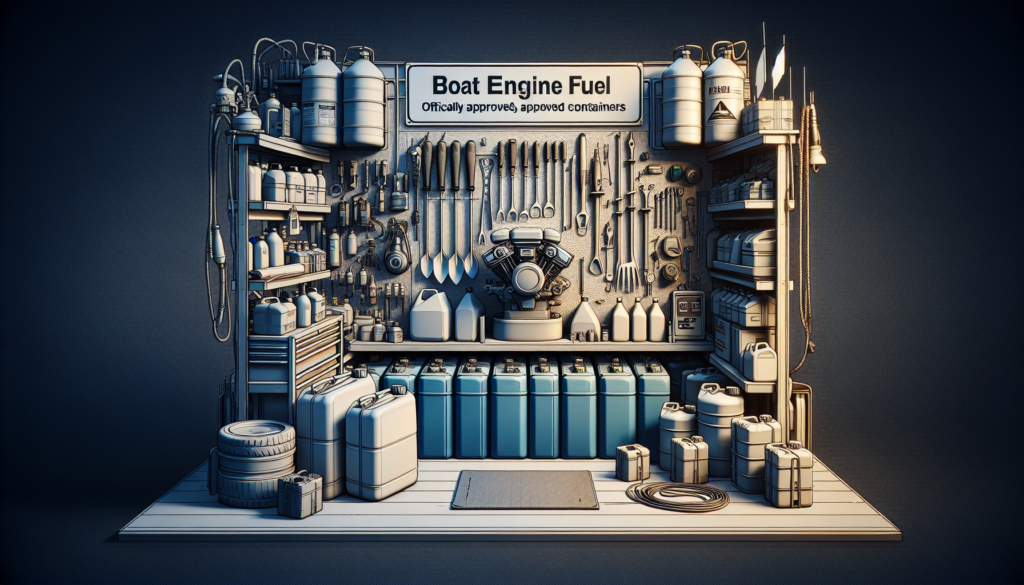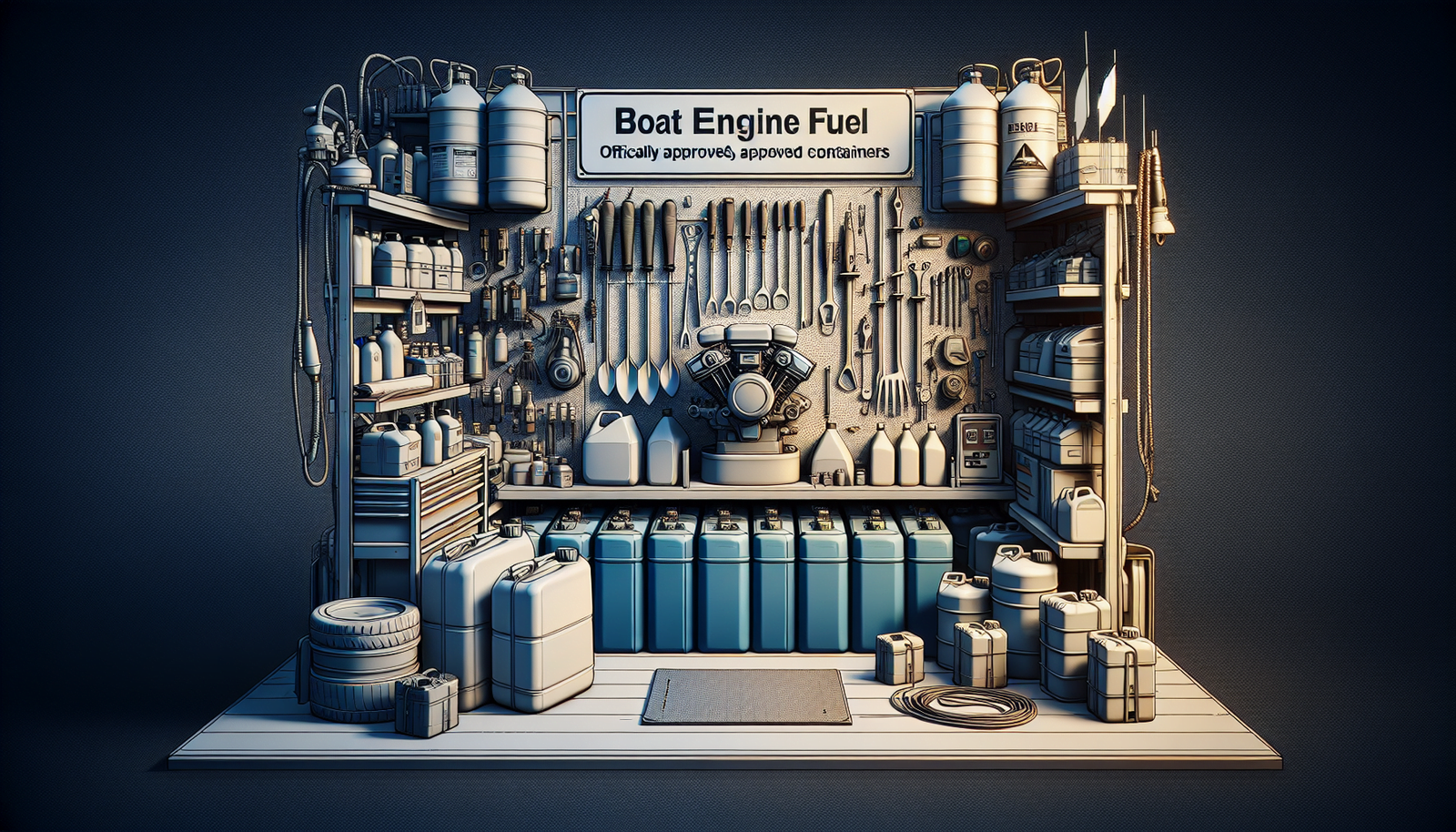Taking care of your boat engine fuel is of utmost importance if you want to extend the life of your boat and keep sailing smoothly for years. In this article, you’ll get to apprehend the best methods to properly store boat engine fuel. From understanding why proper storage matters, to the step-by-step guidance on how to do it, all your concerns will be addressed. The piece offers everything you need to know in order to maintain your boat’s performance and prevent costly repairs down the line. By the end of the article, you’ll be confidently storing your boat engine fuel like a pro.

Understanding the Importance of Proper Fuel Storage
Proper fuel storage for your boat is a crucial aspect that is often overlooked, yet it is fundamentally important for several reasons. The three main factors that accentuate its importance are impacting engine performance, preventing damage and degradation, and ensuring safety on the water.
The impact on engine performance
The quality and condition of the fuel you use can greatly impact the performance of your boat’s engine. Using poorly stored fuel can result in less efficient combustion, reduced power output, and an overall dip in performance. Moreover, your engine could start to demonstrate unusual behaviors, such as knocking, stalling, or struggling to start. Therefore, proper fuel storage plays a critical role in maintaining optimal engine performance.
Preventing damage and degradation
Fuel that is improperly stored can invite multiple damaging consequences to your boat’s engine. For example, oxidation can cause the fuel to break down, creating gum and varnish that can clog your fuel lines, filter and carburetor. Additionally, water contamination can lead to corrosion inside the engine, potentially shortening its lifespan. To prevent these issues, investing time and care into proper fuel storage is essential.
Ensuring safety on the water
Last but not the least, safety on the water is a major concern tied to correct fuel storage. Poorly stored fuel can lead to leaks or spills, raising the risk of fire or explosion. Moreover, vapor from improperly stored fuel can be detrimental to both the crew’s health and the environment. Thus, proper fuel storage guards against potential hazards, shielding you, your crew, and the environment.
Learning the Basics of Boat Fuel
Before delving into storage techniques, it’s important to understand some basic details about boat fuel. This includes acknowledging the types of fuel suitable for boat engines, comprehending the typical shelf-life of various kinds of fuel, and being aware of how different external conditions influence their qualities.
Types of boat engine fuel
The type of fuel your boat’s engine uses is primarily dependent on the design of the engine. The most common types include diesel, gasoline, and to a lesser extent, propane. Each type of fuel has its own characteristics, storage requirements and pros and cons that should be understood for better management of boat fuel.
The average shelf-life of various fuel types
A pivotal factor to remember is that fuel does not last forever. The average shelf-life varies for different types of fuel under ideal storage conditions. Regular gasoline may last three to six months, premium gasoline around six months, and diesel from six months to a year. After these periods, the fuel starts to degrade, and it may negatively affect engine performance if used.
How different external factors affect fuel
Various external factors like temperature, humidity, light, and air can drastically influence fuel quality, speed up degradation, and shorten its lifespan. Understanding how these factors affect your boat’s fuel and its storage can help you devise strategies to counter these influences.
Choosing the Right Storage Containers
The container you choose to store your boat’s fuel plays a significant role in maintaining the fuel’s quality and longevity. The following sub-sections discuss the critical characteristics a good fuel container should possess, the material preferences for fuel containers, and the impact of the size and shape of the container on fuel storage.
Characteristics of a good fuel container
A good fuel storage container should be sturdy, resistant to corrosion, leak-proof, and suitable for long-term storage. It should also have an airtight seal to prevent air exposure. Features such as an easy-pour spout and a handle for secure grip can also be beneficial.
Material considerations for fuel containers
Fuel containers are commonly made from metals like steel or aluminium, or plastic materials. Metal containers are often more durable and less prone to puncture, but can be heavier and more expensive. Plastic containers are lightweight and inexpensive but can degrade over time, especially when exposed to sunlight. Make sure the material is resistant to the type of fuel you are storing.
How size and shape affect fuel storage
Size and shape matter for both practical reasons and for maintaining fuel quality. Larger containers can be more cost-effective when buying fuel in bulk, but they can be more difficult to handle and may increase the risk of fuel degradation over time due to larger fuel-air surface contact. Meanwhile, the ease of handling and storing typically favor smaller containers. As for shape, choose a design that is easy to secure and fits well in your storage space.
Preparing for Fuel Storage
Before storing fuel, there are some necessary preparations needed to ensure the safe and effective storage of fuel. These include checking the quality of the fuel, cleaning the storage container, and obtaining necessary tools and safety equipment.
Checking the quality of the fuel
Before transferring the fuel into the storage container, it’s crucial to check its quality. Look for any signs of contamination or degradation such as changes in color or the presence of fragments or water. Make sure you are not starting your storage process with a subpar fuel.
Cleaning the storage container
Whether you’re using a new container or recycling an old one, cleanliness is key. Clean and dry your chosen containers inside out to prevent contamination of the fuel. This can include washing out residues or dust from the inside and drying thoroughly before use.
Obtaining necessary tools and safety equipment
Tools like funnels and pumps can aid with the safe and tidy transfer of fuel. Additionally, safety equipment, including gloves, safety glasses, and fire extinguishers, should be handy. They serve as your first line of defense against accidental spills, splashes, and potential fires.

Practicing Safe Fuel Transfer
Transferring the fuel from its original container to the storage container without spillage, and safely sealing the container afterwards, can be challenging yet crucial to maintaining the fuel’s quality.
Steps to minimizing spillage
Avoid rushing the process and overfilling the container. Utilize tools like funnels, spouts or pumps to pour the fuel, and ensure the container is placed on a level surface. It is also recommended to leave some headroom at the top of the container to allow for fuel expansion.
Using appropriate funnels and pumps
Appropriate tools can make the fuel transfer process easier, safer and tidier. Use funnels or pumps that are clean and suitable for the type of fuel you are dealing with. After use, remember to clean these tools thoroughly to avoid cross-contamination.
Properly sealing the container after transfer
Once the transfer is completed, it’s crucial to properly seal the container. This step is crucial to prevent air exposure and fuel evaporation which can degrade fuel quality. Ensure the container lid is affixed tightly, and any additional openings or vents are closed securely.
Monitoring Stored Fuel
Regularly checking your stored fuel is an indispensable part of effective fuel storage. Failing to do so may result in using degraded fuel which can detriment your boat’s engine performance and longevity.
Periodical checking of fuel condition
Develop a habit of inspecting your stored fuel periodically. This can range from once a month to every three months, depending on your personal preference and the type of fuel stored. Look for changes in color, clarity, or aroma, and inspect for any signs of visible contamination.
Understanding signs of degradation or contamination
Fuel degradation or contamination often gives visible cues. If the fuel has a darker color than when you stored it, a cloudy appearance, or it has an unusual or stronger smell, these are signs it has degraded. Visible sediment, fragments, or a layer of water at the bottom indicate contamination.
Taking action when fuel quality becomes poor
If you spot signs of degradation or contamination, do not use the fuel. For mildly degraded fuel without contamination, it may be used after adding a fuel stabilizer. For significantly degraded or contaminated fuel, it will need to be disposed of appropriately.
Understanding the Effect of Temperature on Fuel Storage
Temperature plays a key role in the lifespan and condition of stored fuel. This section discusses ways fluctuating temperatures can affect your stored fuel, the ideal temperature range for storage, and how to maintain an optimal temperature for your fuel storage location.
How temperature fluctuations affect fuel
Significant temperature fluctuations can degrade the fuel faster, as the changes facilitate the condensation of water inside the container. Rising temperatures speed up fuel oxidation, while low temperatures can cause certain types of fuel, like diesel, to gel or wax.
Ideal temperature range for fuel storage
The ideal temperature range for most fuel storage is between 20 and 25 degrees Celsius (or 68 to 77 degrees Fahrenheit). Within this range, fuel degradation due to oxidation or condensation can be significantly minimized.
Ways to maintain optimal temperature
Consider storing your fuel in a location that naturally maintains a stable temperature within the ideal range, like a basement or garage. Alternatively, utilizing insulation materials or temperature-controlled storage units can help maintain an optimal temperature for your fuel storage.
Managing Long-term Fuel Storage
Storing fuel for long periods presents its own challenges. Special steps such as extending fuel shelf-life, using fuel stabilizers, and reserving the habit of re-circulating fuel for freshness can make long-term storage successful.
Steps to extending fuel shelf-life
Maximizing your fuel’s shelf-life entails maintaining optimal storage conditions, minimizing the fuel’s exposure to air, and ensuring the container remains sealed tightly. Moreover, choosing the highest quality fuel available can increase its lifespan.
When and how to use fuel stabilizers
Fuel stabilizers can help prolong the shelf-life of fuel by slowing down the process of oxidation. To use them, add the recommended amount to the fuel, then shake or stir gently to mix evenly. These are especially helpful when storing fuel for longer than its average shelf-life.
Re-circulating fuel for freshness
For long-term storage, it’s useful to re-circulate your fuel periodically. This can help mix stabilizers evenly through the fuel and keep the fuel from settling.
Preventing and Handling Fuel Contamination
Contamination can quickly reduce the quality of fuel. It’s important to understand common sources of contamination, identify the signs of contaminated fuel, and learn how to either clean or appropriately dispose of contaminated fuel.
Common sources of fuel contamination
The main sources of fuel contamination are water, dust, and microorganisms. While water and dust can enter through poorly sealed containers, microorganisms such as bacteria and fungi can breed in the water accumulated in the fuel.
Signs of contaminated fuel
In addition to the signs of degradation, contaminated fuel may have a layer of water or sediment at the bottom, or it could have a sludgy consistency. The presence of microorganisms can also result in the fuel exhibiting a bad or ‘rotten’ smell.
How to clean or dispose of contaminated fuel
Cleaning or disposing of contaminated fuel should be done safely and responsibly. Smaller amounts of water or sediment can be filtered out using a fuel-water separator or filter. For heavily contaminated fuel, consider professional services to clean the fuel or dispose of it in accordance to local regulations.
Legal and Environmental Guidelines for Fuel Storage
Lastly, ensure you are aware of and comply with all relevant legal requirements and environmental recommendations for fuel storage.
Understanding government regulations on fuel storage
Government regulations often dictate how much fuel you can store, the type of containers that can be used, and the location and method of storage. Check with local authorities to learn about the specific regulations in your area.
Respecting local guidelines and restrictions
Apart from government regulations, certain marinas or residential communities may have additional guidelines or restrictions when regarding the storage of fuel. Make sure you know and respect these rules to prevent potential legal issues.
Environmental considerations and eco-friendly practices
Lastly, always take the environment into consideration when storing fuel. Use leak-proof containers to prevent spills, avoid overfilling, and dispose of contaminated fuel responsibly. These good practices can help protect your local environment and maintain water integrity.

